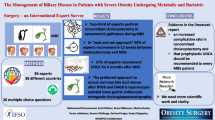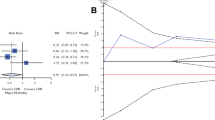Abstract
Background
Gallstone formation is common in obese patients, particularly during rapid weight loss. Whether a concomitant cholecystectomy should be performed during laparoscopic gastric bypass surgery is still contentious. We aimed to analyze trends in concomitant cholecystectomy and laparoscopic gastric bypass surgery (2001–2008), to identify factors associated with concomitant cholecystectomy, and to compare short-term outcomes after laparoscopic gastric bypass with and without concomitant cholecystectomy.
Methods
We used data from adults undergoing laparoscopic gastric bypass for obesity from the Nationwide Inpatient Sample. The Cochran–Armitage trend test was used to assess changes over time. Unadjusted and risk-adjusted generalized linear models were performed to assess predictors of concomitant cholecystectomy and to assess postoperative short-term outcomes.
Results
A total of 70,287 patients were included: mean age was 43.1 years and 81.6% were female. Concomitant cholecystectomy was performed in 6,402 (9.1%) patients. The proportion of patients undergoing concomitant cholecystectomy decreased significantly from 26.3% in 2001 to 3.7% in 2008 (p for trend < 0.001). Patients who underwent concomitant cholecystectomy had higher rates of mortality (unadjusted odds ratios [OR], 2.16; p = 0.012), overall postoperative complications (risk-adjusted OR, 1.59; p = 0.001), and reinterventions (risk-adjusted OR, 3.83; p < 0.001), less frequent routine discharge (risk-adjusted OR, 0.70; p = 0.05), and longer adjusted hospital stay (median difference, 0.4 days; p < 0.001).
Conclusions
Concomitant cholecystectomy and laparoscopic gastric bypass surgery have decreased significantly over the last decade. Given the higher rates of postoperative complications, reinterventions, mortality, as well as longer hospital stay, concomitant cholecystectomy should only be considered in patients with symptomatic gallbladder disease.


Similar content being viewed by others
References
Flegal KM, Carroll MD, Ogden CL, et al. Prevalence and trends in obesity among US adults, 1999–2008. JAMA. 2010;303:235–41.
Santry HP, Gillen DL, Lauderdale DS. Trends in bariatric surgical procedures. JAMA. 2005;294:1909–17.
Kohn GP, Galanko JA, Overby DW, et al. Recent trends in bariatric surgery case volume in the United States. Surgery. 2009;146:375–80.
Sjostrom L, Narbro K, Sjostrom CD, et al. Effects of bariatric surgery on mortality in Swedish obese subjects. N Engl J Med. 2007;357:741–52.
Puzziferri N, Nakonezny PA, Livingston EH, et al. Variations of weight loss following gastric bypass and gastric band. Ann Surg. 2008;248:233–42.
Christou NV, Sampalis JS, Liberman M, et al. Surgery decreases long-term mortality, morbidity, and health care use in morbidly obese patients. Ann Surg. 2004;240:416–23. discussion 423–4.
Keating CL, Dixon JB, Moodie ML, et al. Cost-effectiveness of surgically induced weight loss for the management of type 2 diabetes: modeled lifetime analysis. Diabetes Care. 2009;32:567–74.
Gustafsson U, Benthin L, Granstrom L, et al. Changes in gallbladder bile composition and crystal detection time in morbidly obese subjects after bariatric surgery. Hepatology. 2005;41:1322–8.
Dittrick GW, Thompson JS, Campos D, et al. Gallbladder pathology in morbid obesity. Obes Surg. 2005;15:238–42.
Everhart JE. Contributions of obesity and weight loss to gallstone disease. Ann Intern Med. 1993;119:1029–35.
Villegas L, Schneider B, Provost D, et al. Is routine cholecystectomy required during laparoscopic gastric bypass? Obes Surg. 2004;14:206–11.
Adami Chaim E, da Silva BB, de Oliveira CIgleziasBrandao. Impact of rapid weight reduction on risk of cholelithiasis after bariatric surgery. Obes Surg. 2003;13:625–8.
Nougou A, Suter M. Almost routine prophylactic cholecystectomy during laparoscopic gastric bypass is safe. Obes Surg. 2008;18:535–9.
Liem RK, Niloff PH. Prophylactic cholecystectomy with open gastric bypass operation. Obes Surg. 2004;14:763–5.
Fobi M, Lee H, Igwe D, et al. Prophylactic cholecystectomy with gastric bypass operation: incidence of gallbladder disease. Obes Surg. 2002;12:350–3.
Tucker ON, Fajnwaks P, Szomstein S, et al. Is concomitant cholecystectomy necessary in obese patients undergoing laparoscopic gastric bypass surgery? Surg Endosc. 2008;22:2450–4.
Kim JJ, Schirmer B. Safety and efficacy of simultaneous cholecystectomy at Roux-en-Y gastric bypass. Surg Obes Relat Dis. 2009;5:48–53.
Scott DJ, Villegas L, Sims TL, et al. Intraoperative ultrasound and prophylactic ursodiol for gallstone prevention following laparoscopic gastric bypass. Surg Endosc. 2003;17:1796–802.
Swartz DE, Felix EL. Elective cholecystectomy after Roux-en-Y gastric bypass: why should asymptomatic gallstones be treated differently in morbidly obese patients? Surg Obes Relat Dis. 2005;1:555–60.
Miller K, Hell E, Lang B, et al. Gallstone formation prophylaxis after gastric restrictive procedures for weight loss: a randomized double-blind placebo-controlled trial. Ann Surg. 2003;238:697–702.
Patel KR, White SC, Tejirian T, et al. Gallbladder management during laparoscopic Roux-en-Y gastric bypass surgery: routine preoperative screening for gallstones and postoperative prophylactic medical treatment are not necessary. Am Surg. 2006;72:857–61.
D’Hondt M, Sergeant G, Deylgat B, et al. Prophylactic cholecystectomy, a mandatory step in morbidly obese patients undergoing laparoscopic Roux-en-Y gastric bypass? J Gastrointest Surg. 2011;15:1532–6.
Charlson ME, Pompei P, Ales KL, et al. A new method of classifying prognostic comorbidity in longitudinal studies: development and validation. J Chronic Dis. 1987;40:373–83.
Deyo RA, Cherkin DC, Ciol MA. Adapting a clinical comorbidity index for use with ICD-9-CM administrative databases. J Clin Epidemiol. 1992;45:613–9.
Guller U, Hervey S, Purves H, et al. Laparoscopic versus open appendectomy: outcomes comparison based on a large administrative database. Ann Surg. 2004;239:43–52.
Ahmed AR, O’Malley W, Johnson J, et al. Cholecystectomy during laparoscopic gastric bypass has no effect on duration of hospital stay. Obes Surg. 2007;17:1075–9.
Escalona A, Boza C, Munoz R, et al. Routine preoperative ultrasonography and selective cholecystectomy in laparoscopic Roux-en-Y gastric bypass. Why not? Obes Surg. 2008;18:47–51.
Papasavas PK, Gagne DJ, Ceppa FA, et al. Routine gallbladder screening not necessary in patients undergoing laparoscopic Roux-en-Y gastric bypass. Surg Obes Relat Dis. 2006;2:41–6. discussion 46–7.
Ellner SJ, Myers TT, Piorkowski JR, et al. Routine cholecystectomy is not mandatory during morbid obesity surgery. Surg Obes Relat Dis. 2007;3:456–60.
Li VK, Pulido N, Martinez-Suartez P, et al. Symptomatic gallstones after sleeve gastrectomy. Surg Endosc. 2009;23:2488–92.
Patel JA, Patel NA, Piper GL, et al. Perioperative management of cholelithiasis in patients presenting for laparoscopic Roux-en-Y gastric bypass: have we reached a consensus? Am Surg. 2009;75:470–6. discussion 476.
de Csepel J, Nahouraii R, Gagner M. Laparoscopic gastric bypass as a reoperative bariatric surgery for failed open restrictive procedures. Surg Endosc. 2001;15:393–7.
McCormick JT, Papasavas PK, Caushaj PF, et al. Laparoscopic revision of failed open bariatric procedures. Surg Endosc. 2003;17:413–5.
Hamad GG, Ikramuddin S, Gourash WF, et al. Elective cholecystectomy during laparoscopic Roux-en-Y gastric bypass: is it worth the wait? Obes Surg. 2003;13:76–81.
Guadalajara H, Sanz Baro R, Pascual I, et al. Is prophylactic cholecystectomy useful in obese patients undergoing gastric bypass? Obes Surg. 2006;16:883–5.
Hendolin HI, Paakonen ME, Alhava EM, et al. Laparoscopic or open cholecystectomy: a prospective randomised trial to compare postoperative pain, pulmonary function, and stress response. Eur J Surg. 2000;166:394–9.
Shah J, Shah A, Pietrobon R. Scientific writing of novice researchers: what difficulties and encouragements do they encounter? Acad Med. 2009;84:511–6.
Pietrobon R, Guller U, Martins H, et al. A suite of web applications to streamline the interdisciplinary collaboration in secondary data analyses. BMC Med Res Methodol. 2004;4:29.
Acknowledgment
The authors acknowledge the Team “Research on Research” for the templates for writing the introduction and discussion sections of the manuscript [37] and the templates for literature review [38].
Financial Disclosure/Funding Support
This work was supported by grant PBBEP3-131567 from the Swiss National Science Foundation (MW). The authors have no other potential conflicts of interest, including specific financial interests and relationships and affiliations relevant to the subject matter or materials discussed in the manuscript.
Conflicts of Interest
All contributing authors, including Mathias Worni, Ulrich Guller, Anand Shah, Mihir Gandhi, Jatin Shah, Dimple Rajgor, Ricardo Pietrobon, Danny O. Jacobs, and Truls Østbye, declare that they have no conflicts of interest in relation to this manuscript.
Author information
Authors and Affiliations
Corresponding author
Appendix
Appendix
Rights and permissions
About this article
Cite this article
Worni, M., Guller, U., Shah, A. et al. Cholecystectomy Concomitant with Laparoscopic Gastric Bypass: A Trend Analysis of the Nationwide Inpatient Sample from 2001 to 2008. OBES SURG 22, 220–229 (2012). https://doi.org/10.1007/s11695-011-0575-y
Published:
Issue Date:
DOI: https://doi.org/10.1007/s11695-011-0575-y




